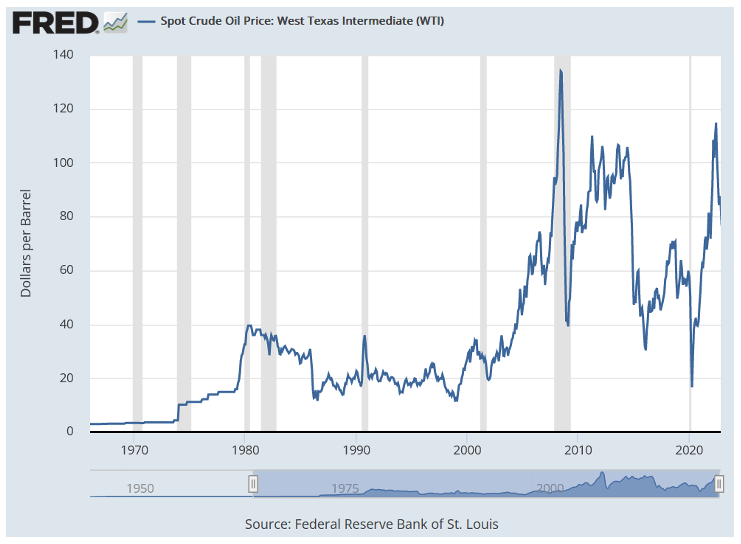Oil, Robots, & American Obesity: This Week In Charts
Want some crude humor? The price of oil over 50 years
Oil is a crucial input to a vast array of products in the modern economy. Besides its uses as a fuel, oil is also essential in making chemicals, plastics, and asphalt, and is employed in electricity generation as well.
Reductions in oil supplies will increase oil prices and therefore impact economic growth and employment. Hence, it’s important to recognize significant oil supply disruptions as they have been linked to recessions.
The chart below plots the price of oil over nearly 6 decades. Recession periods are shaded in gray. Notice the sharp rises in prices that frequently precede recessions. The pattern is not perfect, but it is persuasive. Something to consider after the steep rise in oil since early 2020.
For additional analyses, see FRED.
Robots should start dressing for success
There is much excitement and much unease about ChatGPT (Chat Generative Pre-Trained Transformer) the new AI tool released by OpenAI.
ChatGPT is a conversational bot that produces remarkable human-like text and can be deployed for many purposes including writing short stories, term papers, music, basic programming code, solving math problems, and performing translations. Many have warned that this type of technology will replace millions of white-collar jobs. And recently, Microsoft confirmed a multimillion-dollar investment in OpenAI.
It appears a prudent investment. Other online services have taken far longer to hit the one million users mark. Instagram is the closest, achieving one million users in just 2.5 months. The high interest, novelty, and immediate practical uses of ChatGPT produced an incredible one million users in 5 days!
A degree of concern
There is a notable interest in declining enrollments at colleges and Universities across the nation. In fact, as the costs of education continue to climb, people debate the value of a college degree. Given the tight job market, some employers are even removing college degrees as a requirement for employment. In addition, many complain that college administrators and professors are biased and imbed strong ideological positions in their curriculum and campus events.
The figure below shows how truly unrepresentative college professors are of the general population. Among other items, college professors are overwhelmingly liberal (131% over-representative of the U.S. population). Conversely, very few professors are conservative. Conservative professors are notably under-representative compared to the U.S. population.
These discrepancies of course make headlines and lead ambitious governors (for example Florida) to target the imbalances and rein in ‘trendy’ ideological classes and programs at state universities.
Is “less” really “more”?
Big news, China’s population is shrinking. Like many other countries, China now must deal with the fact that deaths outnumber births. Nearly all advanced economic societies are expected to age substantially in the decades ahead. This puts pressure on immigration policies. Indeed, those countries that can grow a younger population may have an edge.
Why? Because when a country gets older, it means a shrinking percentage of workers must support an increasing percentage of retirees – the old-age dependency ratio (65plus/18-64) is much too high in nearly every advanced country, especially Japan. Younger people must then endure higher taxes to maintain programs like Social Security and Medicare.
However, some argue that an aging population really does not matter much. Yes, there will be a huge number of retirees but perhaps their labor can be replaced with robots – consider the Chatbot mentioned above. And, with fewer people on the earth pressures on scarce resources will decline – making living arrangements and standards even better for younger people.
The growing number of obese Americans is quite weighty
Not much to say here. This is a problem on multiple levels (individual, community, society) and the figure demonstrates how quickly it can penetrate a nation.



































Manifest 2024 served as a reminder of the immense potential that lies ahead in the realm of supply chain technology.